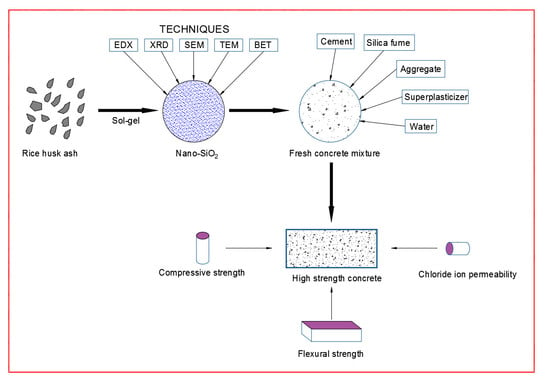Mechanical Properties of High Strength Concrete Containing Nano SiO2 Made from Rice Husk Ash in Southern Vietnam
Abstract
:1. Introduction
2. Experimental Program
2.1. Materials
2.1.1. Ordinary Portland Cement
2.1.2. Fine Aggregate
2.1.3. Coarse Aggregate
2.1.4. Superplasticizers
2.1.5. Silica Fume
2.1.6. Nano SiO2 Produced from Rice Husk Ash
2.2. Mix Proportions and Sample Preparation
2.2.1. Design Standards and Techniques
2.2.2. Mix Proportions
2.2.3. Specimen Preparation and Testing Procedures
2.2.4. HSC Compressive and Flexural Strength Tests
2.2.5. Experiment to Determine Chloride Ion Permeability of HSC
3. Results and Discussions
3.1. Modulation and Characteristics of Nano SiO2
3.1.1. Nano-SiO2 Modulation
3.1.2. Energy-Dispersive X-ray Spectroscopy (EDX)
3.1.3. X-ray Diffraction (XRD)
3.1.4. Scanning Electron Microscope (SEM)
3.1.5. Transmission Electron Microscopy (TEM)
3.1.6. Brunauer Emmett Teller (BET)
3.2. Mechanical Properties HSC Added with NS
3.2.1. Compressive Strength and Flexural Strengths at Early Curing Age
3.2.2. Effect of NS Content on Strength Development
3.2.3. Correlation between Compressive Strength and Flexural Strength
3.3. Chloride Ion Penetration
4. Conclusions
Author Contributions
Funding
Conflicts of Interest
References
- Chen, J.-F.; Ding, H.-M.; Wang, J.-X.; Shao, L. Preparation and characterization of porous hollow silica nanoparticles for drug delivery application. Biomaterials 2004, 25, 723–727. [Google Scholar] [CrossRef]
- Wu, L.; Lu, Z.; Zhuang, C.; Chen, Y.; Hu, R. Mechanical Properties of Nano SiO2 and Carbon Fiber Reinforced Concrete after Exposure to High Temperatures. Materials 2019, 12, 3773. [Google Scholar] [CrossRef] [PubMed] [Green Version]
- Tambichik, M.A.; Mohamad, N.; Samad, A.A.A.; Bosro, M.Z.M.; Iman, M.A. Utilization of construction and agricultural waste in Malaysia for development of Green Concrete: A Review. IOP Conf. Ser. Earth Environ. Sci. 2018, 140, 012134. [Google Scholar] [CrossRef] [Green Version]
- Hossain, S.S.; Mathur, L.; Roy, P.K. Rice husk/rice husk ash as an alternative source of silica in ceramics: A review. J. Asian Ceram. Soc. 2018, 6, 299–313. [Google Scholar] [CrossRef]
- Le, V.H.; Thuc, C.N.H.; Thuc, H.H. Synthesis of silica nanoparticles from Vietnamese rice husk by sol–gel method. Nanoscale Res. Lett. 2013, 8, 58. [Google Scholar] [CrossRef] [Green Version]
- Venkateswaran, S.; Yuvakkumar, R.; Rajendran, V. Nano Silicon from Nano Silica Using Natural Resource (Rha) for Solar Cell Fabrication. Phosphorus Sulfur Silicon Relat. Elem. 2013, 188, 1178–1193. [Google Scholar] [CrossRef]
- Fares, G.; Khan, M.I. Nanosilica and its Future Prospects in Concrete. Adv. Mater. Res. 2013, 658, 50–55. [Google Scholar] [CrossRef]
- Luo, Z.; Cai, X.; Hong, R.Y.; Wang, L.S.; Feng, W.G. Preparation of silica nanoparticles using silicon tetrachloride for reinforcement of PU. Chem. Eng. J. 2012, 187, 357–366. [Google Scholar] [CrossRef]
- Wang, L.E.I.; Guo, F.; Yang, H.; Wang, Y.A.N.; Tang, S. Comparison of fly ash, PVA fiber, MGO and shrinkage-reducing admixture on the frost resistance of face slab concrete pore structural and fractal analysis. Fractals 2020, 29, 2140002. [Google Scholar] [CrossRef]
- Zhang, P.; Li, Q.-F.; Wang, J.; Shi, Y.; Ling, Y.-F. Effect of PVA fiber on durability of cementitious composite containing nano-SiO2. Nanotechnol. Rev. 2019, 8, 116–127. [Google Scholar] [CrossRef]
- Wang, L.E.I.; Jin, M.; Guo, F.; Wang, Y.A.N.; Tang, S. Pore structural and fractal analysis of the influence of fly ash and silica fume on the mechanical property and abrasion resistance of concrete. Fractals 2020, 29, 2140003. [Google Scholar] [CrossRef]
- Qin, Y.; Zhang, X.; Chai, J.; Xu, Z.; Li, S. Experimental study of compressive behavior of polypropylene-fiber-reinforced and polypropylene-fiber-fabric-reinforced concrete. Constr. Build. Mater. 2019, 194, 216–225. [Google Scholar] [CrossRef]
- Qin, Y.; Li, M.; Li, Y.; Ma, W.; Xu, Z.; Chai, J.; Zhou, H. Effects of nylon fiber and nylon fiber fabric on the permeability of cracked concrete. Constr. Build. Mater. 2021, 274, 121786. [Google Scholar] [CrossRef]
- Wang, L.; Jin, M.; Wu, Y.; Zhou, Y.; Tang, S. Hydration, shrinkage, pore structure and fractal dimension of silica fume modified low heat Portland cement-based materials. Constr. Build. Mater. 2021, 272, 121952. [Google Scholar] [CrossRef]
- Fu, C.; Xie, C.; Liu, J.; Wei, X.; Wu, D. A Comparative Study on the Effects of Three Nano-Materials on the Properties of Cement-Based Composites. Materials 2020, 13, 857. [Google Scholar] [CrossRef] [Green Version]
- Aggarwal, P.; Singh, R.P.; Aggarwal, Y. Use of nano-silica in cement based materials—A review. Cogent Eng. 2015, 2, 1078018. [Google Scholar] [CrossRef]
- Colston, S.L.; O’Connor, D.; Barnes, P.; Mayes, E.L.; Mann, S.; Freimuth, H.; Ehrfeld, W. Functional micro-concrete: The incorporation of zeolites and inorganic nano-particles into cement micro-structures. J. Mater. Sci. Lett. 2000, 19, 1085–1088. [Google Scholar] [CrossRef]
- Du, H.; Du, S.; Liu, X. Durability performances of concrete with nano-silica. Constr. Build. Mater. 2014, 73, 705–712. [Google Scholar] [CrossRef] [Green Version]
- Zhang, M.-H.; Li, H. Pore structure and chloride permeability of concrete containing nano-particles for pavement. Constr. Build. Mater. 2011, 25, 608–616. [Google Scholar] [CrossRef]
- Xu, W.; Lo, T.Y.; Wang, W.; Ouyang, D.; Wang, P.; Xing, F. Pozzolanic Reactivity of Silica Fume and Ground Rice Husk Ash as Reactive Silica in a Cementitious System: A Comparative Study. Materials 2016, 9, 146. [Google Scholar] [CrossRef] [Green Version]
- Mussa, M.H.; Abdulhadi, A.M.; Abbood, I.S.; Mutalib, A.A.; Yaseen, Z.M. Late Age Dynamic Strength of High-Volume Fly Ash Concrete with Nano-Silica and Polypropylene Fibres. Crystals 2020, 10, 243. [Google Scholar] [CrossRef] [Green Version]
- Rai, S.; Tiwari, S. Nano Silica in Cement Hydration. Mater. Today Proc. 2018, 5, 9196–9202. [Google Scholar] [CrossRef]
- Jo, B.W.; Kim, C.H.; Lim, J.H. Investigations on the development of powder concrete with nano-SiO2 particles. KSCE J. Civ. Eng. 2007, 11, 37–42. [Google Scholar] [CrossRef]
- Nazari, A.; Riahi, S. Microstructural, thermal, physical and mechanical behavior of the self compacting concrete containing SiO2 nanoparticles. Mater. Sci. Eng. A 2010, 527, 7663–7672. [Google Scholar] [CrossRef]
- Said, A.M.; Zeidan, M.S.; Bassuoni, M.T.; Tian, Y. Properties of concrete incorporating nano-silica. Constr. Build. Mater. 2012, 36, 838–844. [Google Scholar] [CrossRef]
- Zhang, P.; Ling, Y.; Wang, J.; Shi, Y. Bending resistance of PVA fiber reinforced cementitious composites containing nano-SiO2. Nanotechnol. Rev. 2019, 8, 690–698. [Google Scholar] [CrossRef] [Green Version]
- Ling, Y.; Zhang, P.; Wang, J.; Taylor, P.; Hu, S. Effects of nanoparticles on engineering performance of cementitious composites reinforced with PVA fibers. Nanotechnol. Rev. 2020, 9, 504–514. [Google Scholar] [CrossRef]
- Zhang, P.; Sha, D.; Li, Q.; Zhao, S.; Ling, Y. Effect of Nano Silica Particles on Impact Resistance and Durability of Concrete Containing Coal Fly Ash. Nanomaterials 2021, 11, 1296. [Google Scholar] [CrossRef]
- Amin, M.; Abu el-hassan, K. Effect of using different types of nano materials on mechanical properties of high strength concrete. Constr. Build. Mater. 2015, 80, 116–124. [Google Scholar] [CrossRef]
- Shah, A.H.; Sharma, U.K.; Roy, D.A.B.; Bhargava, P. Spalling behaviour of nano SiO2 high strength concrete at elevated temperatures. MATEC Web Conf. 2013, 6, 01009. [Google Scholar] [CrossRef] [Green Version]
- Shahbazpanahi, S.; Tajara, M.K.; Faraj, R.H.; Mosavi, A. Studying the C–H Crystals and Mechanical Properties of Sustainable Concrete Containing Recycled Coarse Aggregate with Used Nano-Silica. Crystals 2021, 11, 122. [Google Scholar] [CrossRef]
- Ghafoori, N.; Moradi, B.; Najimi, M.; Hasnat, A. Transport properties of nano-silica contained self-consolidating concrete. Constr. Build. Mater. 2021, 301, 124060. [Google Scholar] [CrossRef]
- Li, C. Chloride permeability and chloride binding capacity of nano-modified concrete. J. Build. Eng. 2021, 41, 102419. [Google Scholar] [CrossRef]
- Li, G.; Ding, Y.; Gao, T.; Qin, Y.; Lv, Y.; Wang, K. Chloride resistance of concrete containing nanoparticle-modified polymer cementitious coatings. Constr. Build. Mater. 2021, 299, 123736. [Google Scholar] [CrossRef]
- Li, G.; Zhou, J.; Yue, J.; Gao, X.; Wang, K. Effects of nano-SiO2 and secondary water curing on the carbonation and chloride resistance of autoclaved concrete. Constr. Build. Mater. 2020, 235, 117465. [Google Scholar] [CrossRef]
- Wang, B.; Zhao, R. Effect of graphene nano-sheets on the chloride penetration and microstructure of the cement based composite. Constr. Build. Mater. 2018, 161, 715–722. [Google Scholar] [CrossRef]
- ASTM C618. Standard Specification for Coal Fly Ash and Raw or Calcined Natural Pozzolan for Use in Concrete; ASTM: West Conshohocken, PA, USA, 2003. [Google Scholar]
- ASTM C29. Standard Test Method for Bulk Density (“Unit Weight”) and Voids in Aggregate; ASTM: West Conshohocken, PA, USA, 2017. [Google Scholar]
- TCVN 8826. Chemical Admixtures for Concrete; ASTM: West Conshohocken, PA, USA, 2011. [Google Scholar]
- ASTM C1240. Standard Specification for Silica Fume Used in Cementitious Mixtures; ASTM: West Conshohocken, PA, USA, 2004. [Google Scholar]
- ACI 211.4R-08. Guide for Selecting Proportions for High-Strength Concrete Using Portland Cement and Other Cementitious Mater; ASTM: West Conshohocken, PA, USA, 2008. [Google Scholar]
- Zhang, P.; Li, Q.-F. Effect of silica fume on durability of concrete composites containing fly ash. Sci. Eng. Compos. Mater. 2013, 20, 57–65. [Google Scholar] [CrossRef]
- Mazloom, M.; Ramezanianpour, A.A.; Brooks, J.J. Effect of silica fume on mechanical properties of high-strength concrete. Cem. Concr. Compos. 2004, 26, 347–357. [Google Scholar] [CrossRef]
- Jianyong, L.; Pei, T. Effect of slag and silica fume on mechanical properties of high strength concrete. Cem. Concr. Res. 1997, 27, 833–837. [Google Scholar] [CrossRef]
- ASTM C78. Standard Test Method for Flexural Strength of Concrete (Using Simple Beam with Third-Point Loading); ASTM: West Conshohocken, PA, USA, 1994. [Google Scholar]
- ASTM C1202. Standard Test Method for Electrical Indication of Concrete’s Ability to Resist Chloride Ion Penetration; ASTM: West Conshohocken, PA, USA, 2019. [Google Scholar]
- Esposito, S. “Traditional” Sol-Gel Chemistry as a Powerful Tool for the Preparation of Supported Metal and Metal Oxide Catalysts. Materials 2019, 12, 668. [Google Scholar] [CrossRef] [PubMed] [Green Version]
- Nair, P.A.K.; Vasconcelos, W.L.; Paine, K.; Calabria-Holley, J. A review on applications of sol-gel science in cement. Constr. Build. Mater. 2021, 291, 123065. [Google Scholar] [CrossRef]
- Shakhmenko, G.; Juhnevica, I.; Korjakins, A. Influence of Sol-Gel Nanosilica on Hardening Processes and Physically-Mechanical Properties of Cement Paste. Procedia Eng. 2013, 57, 1013–1021. [Google Scholar] [CrossRef] [Green Version]
- Khaloo, A.; Mobini, M.H.; Hosseini, P. Influence of different types of nano-SiO2 particles on properties of high-performance concrete. Constr. Build. Mater. 2016, 113, 188–201. [Google Scholar] [CrossRef]
- Naji Givi, A.; Abdul Rashid, S.; Aziz, F.N.A.; Salleh, M.A.M. The effects of lime solution on the properties of SiO2 nanoparticles binary blended concrete. Compos. Part B Eng. 2011, 42, 562–569. [Google Scholar] [CrossRef]
- Rong, Z.; Sun, W.; Xiao, H.; Jiang, G. Effects of nano-SiO2 particles on the mechanical and microstructural properties of ultra-high performance cementitious composites. Cem. Concr. Compos. 2015, 56, 25–31. [Google Scholar] [CrossRef]
- Ganesh, P.; Murthy, A.R.; Kumar, S.S.; Reheman, M.M.S.; Iyer, N.R. Effect of nanosilica on durability and mechanical properties of high-strength concrete. Mag. Concr. Res. 2016, 68, 229–236. [Google Scholar] [CrossRef]
- Serag, M.I.; Yasien, A.M.; El-Feky, M.S.; Elkady, H. Effect of Nano Silica on Concrete Bond Strength Modes of Failure. Int. J. GEOMATE 2017, 12, 73–80. [Google Scholar]
- Ngo, V.-T.; Bui, T.-T.; Lam, T.-Q.-K.; Nguyen, T.-T.-N.; Nguyen, V.-H. Experimental Evaluation of Nano Silica Effects to High Performance Concrete Strength in Early Age. IOP Conf. Ser. Mater. Sci. Eng. 2020, 869, 032011. [Google Scholar] [CrossRef]
- Balapour, M.; Joshaghani, A.; Althoey, F. Nano-SiO2 contribution to mechanical, durability, fresh and microstructural characteristics of concrete: A review. Constr. Build. Mater. 2018, 181, 27–41. [Google Scholar] [CrossRef]
- Hosseinpourpia, R.; Varshoee, A.; Soltani, M.; Hosseini, P.; Ziaei Tabari, H. Production of waste bio-fiber cement-based composites reinforced with nano-SiO2 particles as a substitute for asbestos cement composites. Constr. Build. Mater. 2012, 31, 105–111. [Google Scholar] [CrossRef]
- Sanjuán, M.A.; Argiz, C.; Gálvez, J.C.; Reyes, E. Combined effect of nano-SiO2 and nano-Fe2O3 on compressive strength, flexural strength, porosity and electrical resistivity in cement mortars. Mater. Constr. 2018, 68, 9. [Google Scholar] [CrossRef]
- Committee, A.C.I. Prediction of Creep, Shrinkage, and Temperature Effects in Concrete Structures. ACI Symp. Publ. 1997. [Google Scholar] [CrossRef]
- Abbasi, S.M.; Ahmadi, H.; Khalaj, G.; Ghasemi, B. Microstructure and mechanical properties of a metakaolinite-based geopolymer nanocomposite reinforced with carbon nanotubes. Ceram. Int. 2016, 42, 15171–15176. [Google Scholar] [CrossRef]
- Beeby, A.W.; Naranayan, R.S. Designers Handbook to Eurocode 2 Part I: Design of Concrete Structures; Thomas Telford Services Ltd.: London, UK, 1995. [Google Scholar]
- Zhang, P.; Wan, J.; Wang, K.; Li, Q. Influence of nano-SiO2 on properties of fresh and hardened high performance concrete: A state-of-the-art review. Constr. Build. Mater. 2017, 148, 648–658. [Google Scholar] [CrossRef]






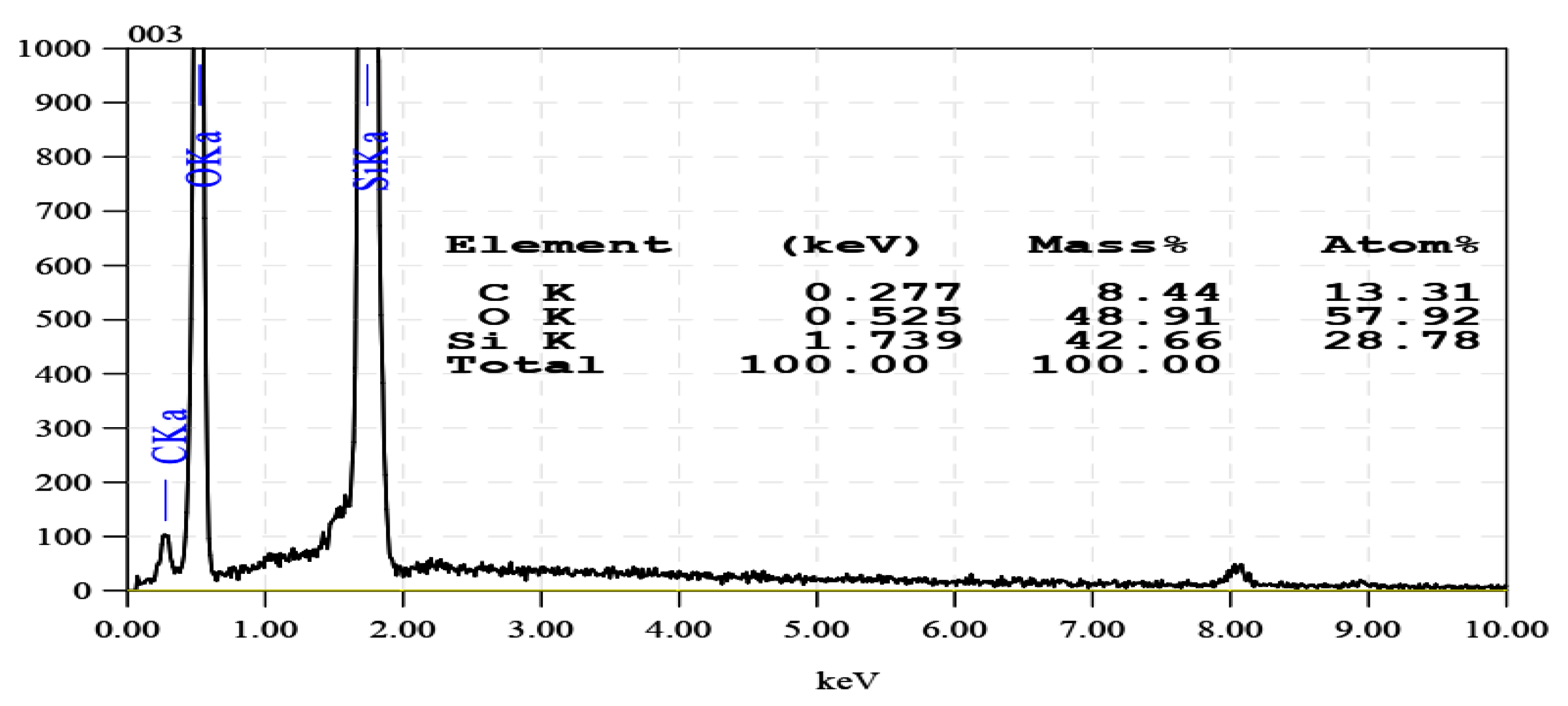
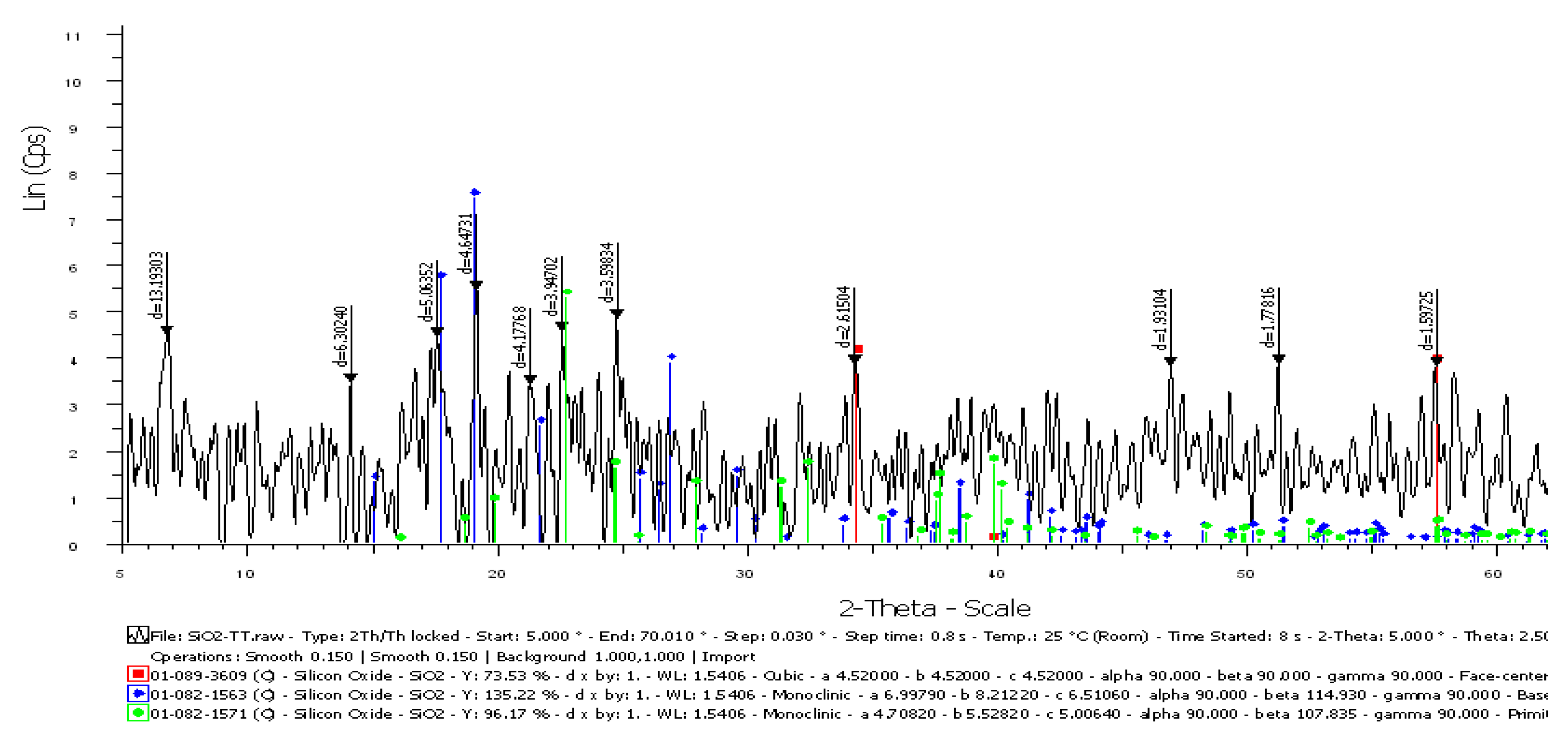

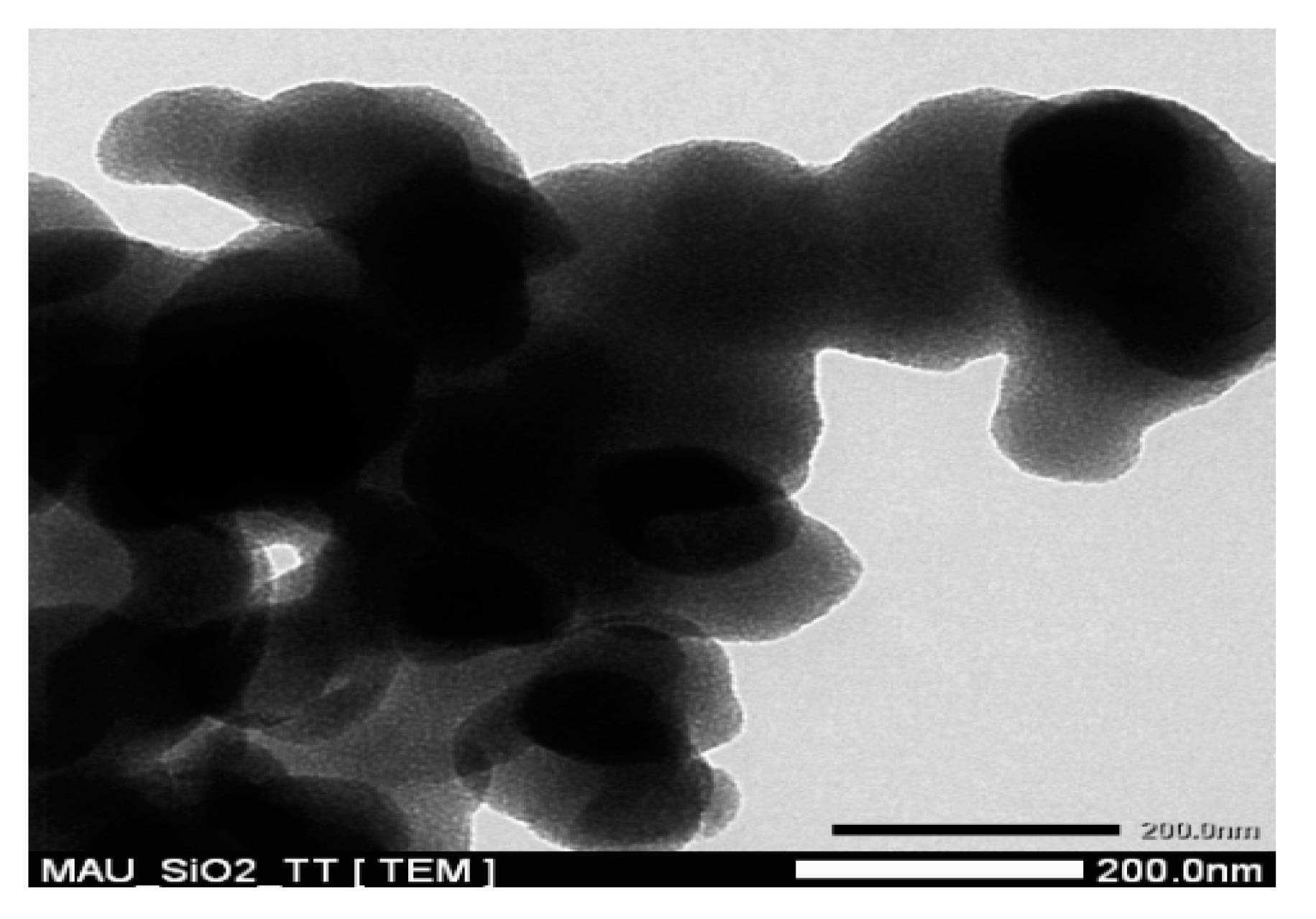

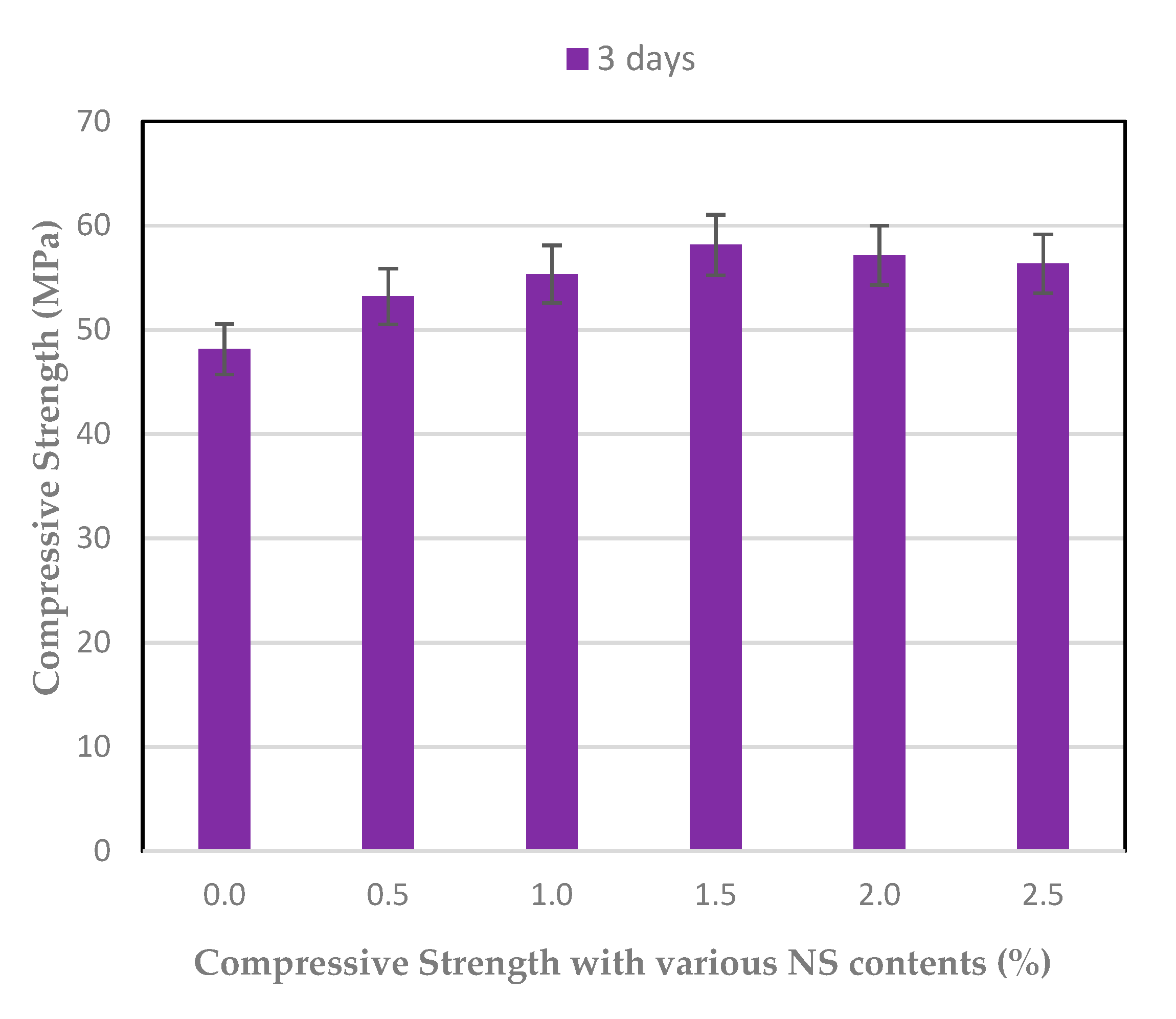

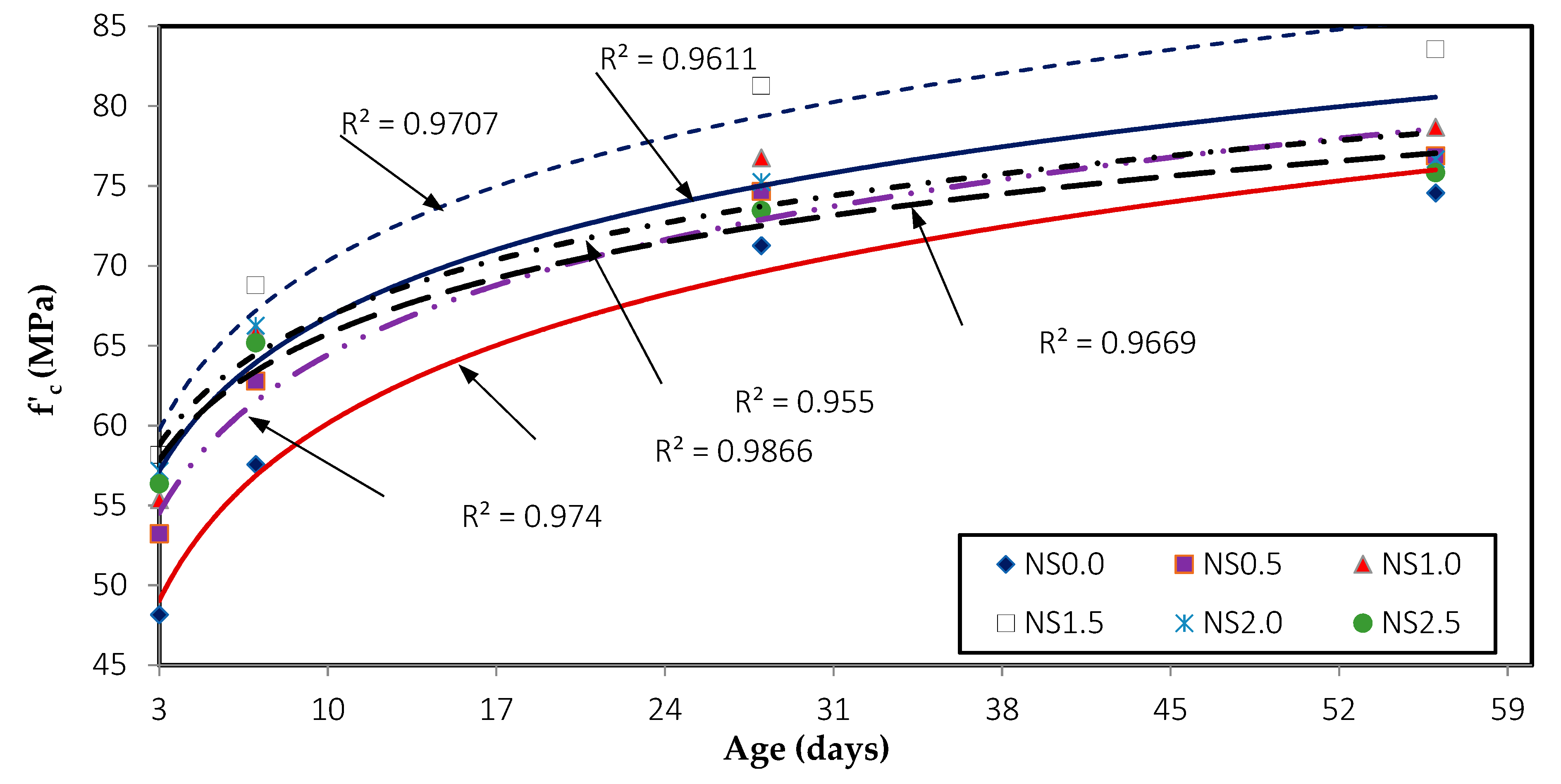

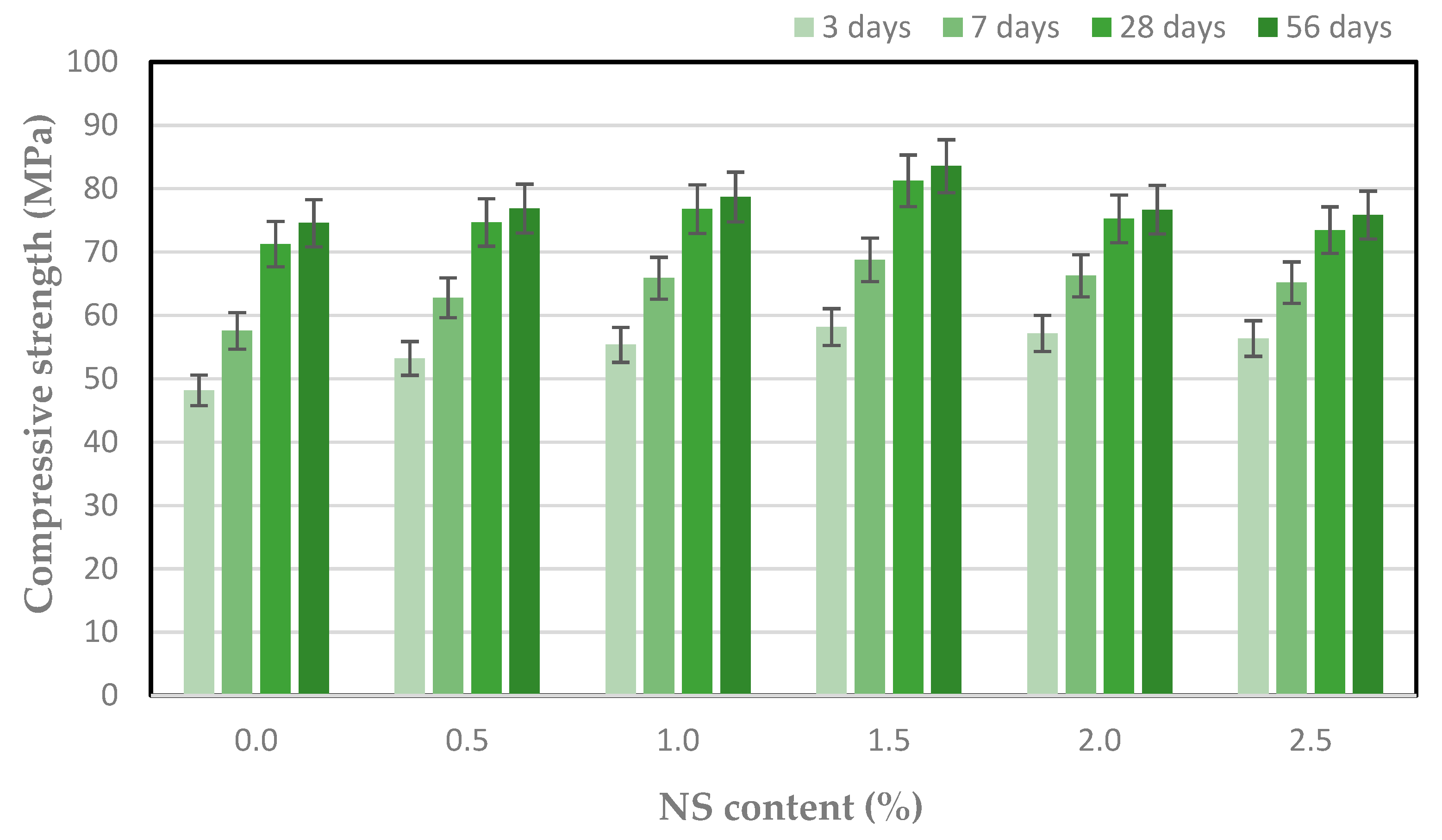
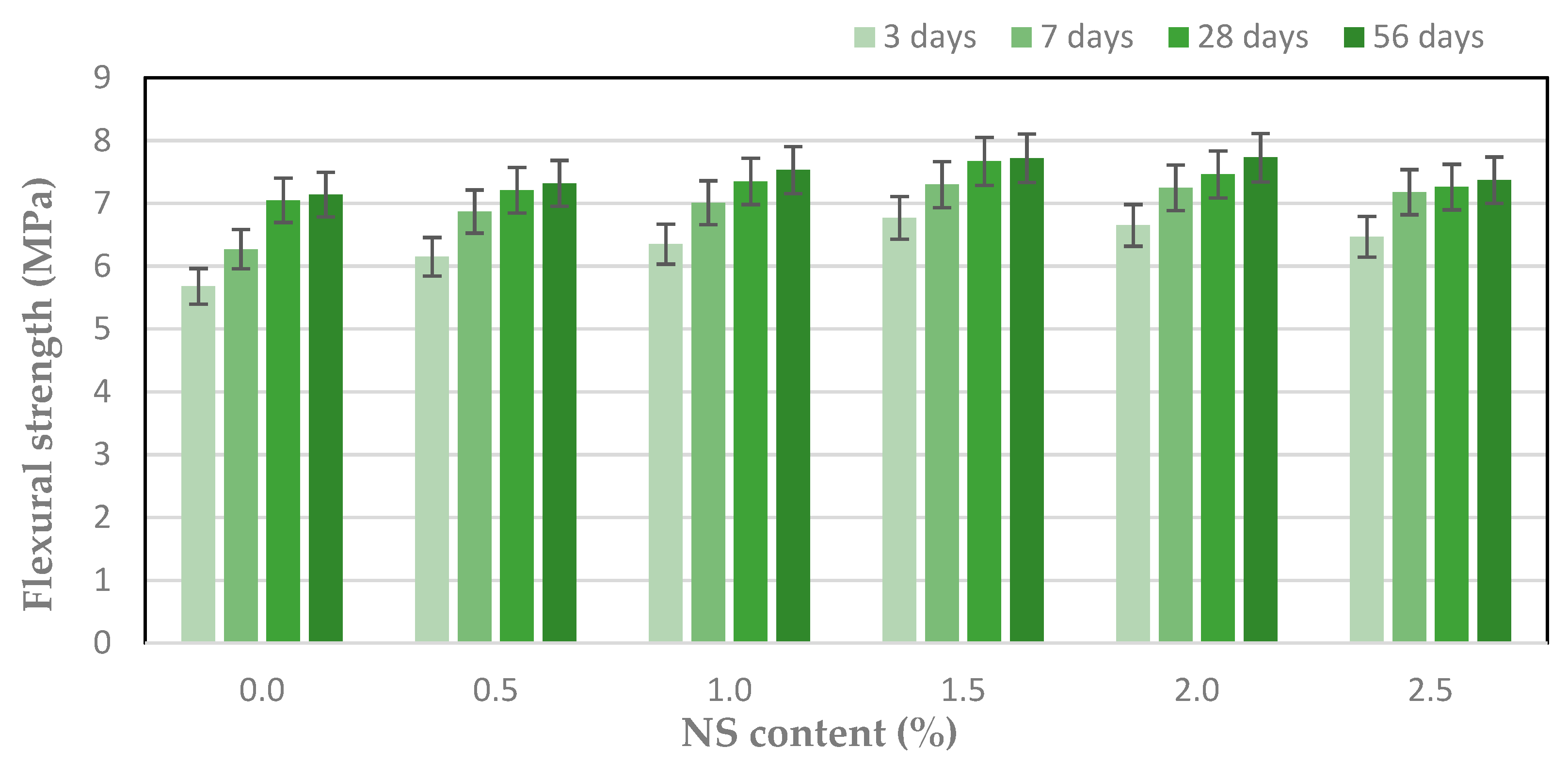
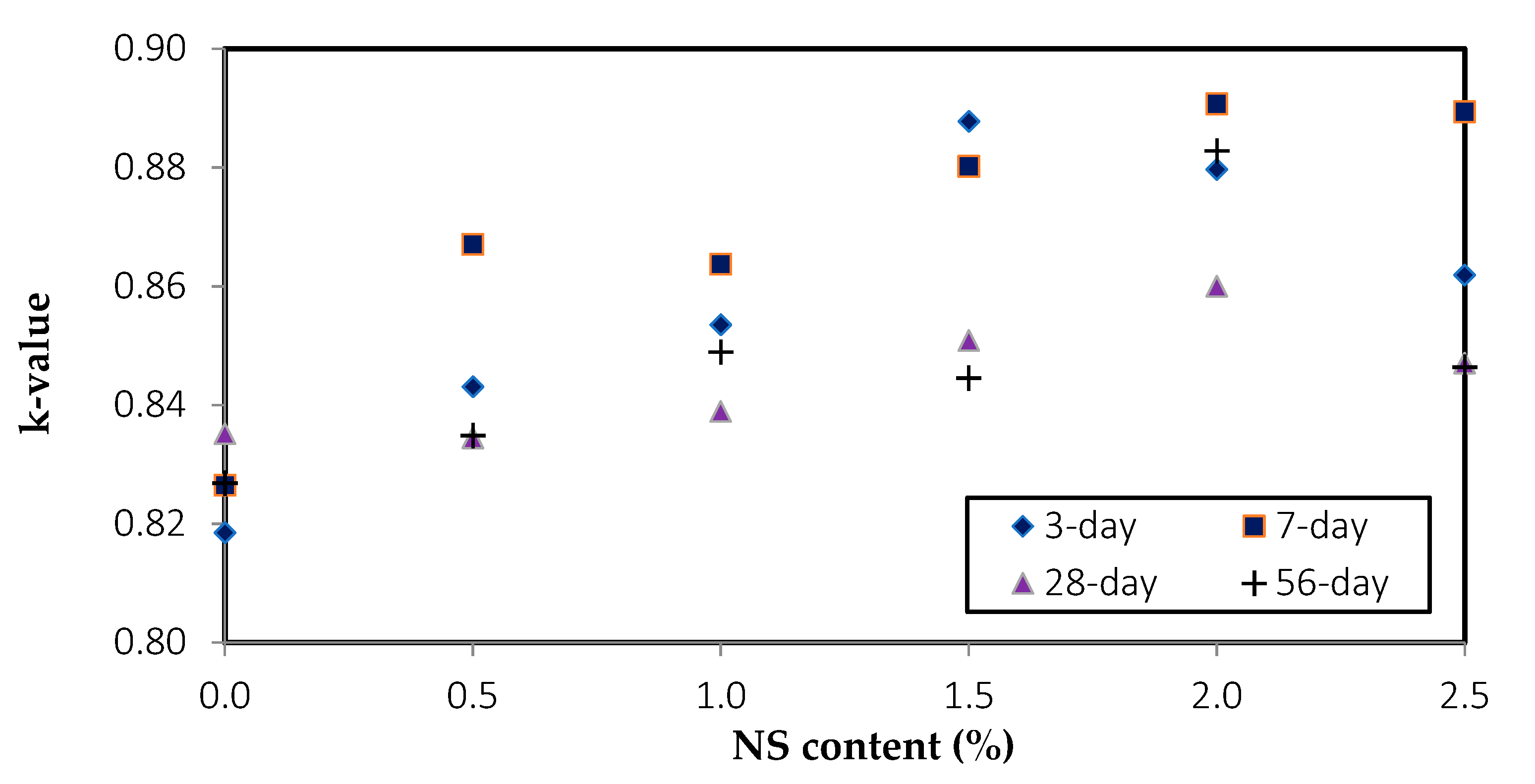

| SiO2 | Al2O3 | Fe2O3 | CaO | MgO | Na2O3 | K2O | SO3 |
|---|---|---|---|---|---|---|---|
| 21.65 | 5.25 | 3.42 | 65.13 | 0.06 | 0.25 | 0.72 | 0.18 |
| C3S | C2S | C3A | C4AF |
|---|---|---|---|
| 51.74 | 24.20 | 8.16 | 10.35 |
| Specific Gravity | Setting Time (min) | Compressive Strength (MPa) | Flexural Strength (MPa) | |||
|---|---|---|---|---|---|---|
| Initial Setting | Final Setting | 3 Day | 28 Day | 3 Day | 28 Day | |
| 3.1 | 128 | 250 | 28.5 | 55.7 | 5.8 | 8.6 |
| Physical Properties of River Sand | ||||
|---|---|---|---|---|
| Fineness Modulus | Water Absorption (%) | Specific Gravity | Bulk Unit Weight of Sand (g/cm3) | Moisture Content (%) |
| 2.5 | 0.87 | 2.66 | 1.732 | 2.0 |
| Percentage Passes of Fine Aggregates | ||||||
|---|---|---|---|---|---|---|
| Sieve Sizes | 4.75 mm | 2.36 mm | 1.18 mm | 600 μm | 300 μm | 150 μm |
| Percentage Passing (ASTM C33 Standard) | 95–100 | 80–100 | 50–85 | 25–60 | 5–30 | 0–10 |
| Cumulative (%) Passed | 100 | 91.97 | 81.76 | 57.88 | 12.07 | 5.36 |
| Dmax (mm) | Water Absorption (%) | Specific Gravity | Bulk Unit Weight (g/cm3) | Moisture Content (%) |
|---|---|---|---|---|
| 9.5 | 0.87 | 2.78 | 1.613 | 0.48 |
| Percentage Passes of Coarse Aggregate | |||||
|---|---|---|---|---|---|
| Sieve Size | 12.5 mm | 9.5 mm | 4.75 mm | 2.36 mm | 1.18 mm |
| Percentage Passing (ASTM C33) | 100 | 85–100 | 10–30 | 0–10 | 0–5 |
| Cumulative (%) Passed | 100 | 92.5 | 10 | 5 | 2.5 |
| SiO2 | Fe2O3 | CaO | MgO | Na2O | C | K2O | Al2O3 | Other Substances |
|---|---|---|---|---|---|---|---|---|
| 95.38 | 0.0063 | 0.13 | 0.37 | 0.28 | 0.007 | 1.53 | 0.20 | 3.859 |
| Mix Code | Proportions of Concrete Mix for 1 m3 | |||||||
|---|---|---|---|---|---|---|---|---|
| C 1 | S 2 | CA 3 | SF 4 | NS 5 | SP 6 | Water | W/B 7 | |
| (kg) | (kg) | (kg) | (kg) | (%) | (kg) | (kg) | ||
| NS0.0 | 485.46 | 685.76 | 1048.45 | 42.21 | 0.00 | 4.37 | 158.76 | 0.30 |
| NS0.5 | 482.82 | 684.83 | 1048.45 | 42.21 | 0.50 | 5.31 | 158.76 | 0.30 |
| NS1.0 | 480.18 | 683.90 | 1048.45 | 42.21 | 1.00 | 6.24 | 158.76 | 0.30 |
| NS1.5 | 477.55 | 682.98 | 1048.45 | 42.21 | 1.50 | 7.16 | 158.76 | 0.30 |
| NS2.0 | 474.85 | 682.10 | 1048.45 | 42.21 | 2.00 | 8.07 | 158.76 | 0.30 |
| NS2.5 | 472.27 | 681.14 | 1048.45 | 42.21 | 2.50 | 8.97 | 158.76 | 0.30 |
| Properties | Value |
|---|---|
| Average particle size (nm) | 15 ± 3 |
| Specific surface area (m2/g) | 258.3 |
| Specific gravity (g/cm3) | 2.2 |
| Apparent density (g/L) | 52 |
| pH value | 3 |
| Mix | NS Content | α | β | R2 |
|---|---|---|---|---|
| NS0.0 | 0.0 | 1.78 | 0.91 | 0.95 |
| NS0.5 | 0.5 | 1.48 | 0.93 | 0.97 |
| NS1.0 | 1.0 | 1.41 | 0.92 | 0.98 |
| NS1.5 | 1.5 | 1.46 | 0.93 | 0.97 |
| NS2.0 | 2.0 | 1.15 | 0.94 | 0.98 |
| NS2.5 | 2.5 | 1.14 | 0.93 | 0.98 |
| No | Country | Standard | Formulation |
|---|---|---|---|
| 1 | India | IS: 456-2000 | |
| 2 | USA | ACI | |
| 3 | New Zealand | NZS-3101 | |
| 4 | Europe | EC-02 | |
| 5 | Britain | BS-8110 |
Publisher’s Note: MDPI stays neutral with regard to jurisdictional claims in published maps and institutional affiliations. |
© 2021 by the authors. Licensee MDPI, Basel, Switzerland. This article is an open access article distributed under the terms and conditions of the Creative Commons Attribution (CC BY) license (https://creativecommons.org/licenses/by/4.0/).
Share and Cite
Tran, H.-B.; Le, V.-B.; Phan, V.T.-A. Mechanical Properties of High Strength Concrete Containing Nano SiO2 Made from Rice Husk Ash in Southern Vietnam. Crystals 2021, 11, 932. https://doi.org/10.3390/cryst11080932
Tran H-B, Le V-B, Phan VT-A. Mechanical Properties of High Strength Concrete Containing Nano SiO2 Made from Rice Husk Ash in Southern Vietnam. Crystals. 2021; 11(8):932. https://doi.org/10.3390/cryst11080932
Chicago/Turabian StyleTran, Huu-Bang, Van-Bach Le, and Vu To-Anh Phan. 2021. "Mechanical Properties of High Strength Concrete Containing Nano SiO2 Made from Rice Husk Ash in Southern Vietnam" Crystals 11, no. 8: 932. https://doi.org/10.3390/cryst11080932





